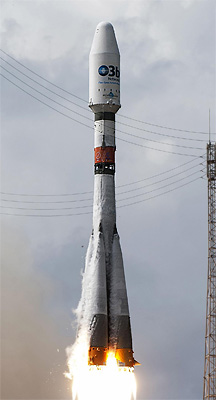
Soyuz STB
ActiveProgress Rocket Space Center (PRSC)
Oct. 12, 2012
Description
The 2.1b version adds an upgraded engine (RD-0124) with improved performance to the second stage. First launch took place from Plesetsk Cosmodrome Site 43 on 26 July 2008 with a classified military payload. The 2.1b/ST version is sometimes called Soyuz ST-B.
Specifications
-
Stages
3 -
Length
46.3 m -
Diameter
2.95 m -
Fairing Diameter
― -
Launch Mass
310.0 T -
Thrust
―
Family
-
Name
Soyuz STB -
Family
― -
Variant
Fregat-MT -
Alias
― -
Full Name
Soyuz STB Fregat-MT
Payload Capacity
-
Launch Cost
$80000000 -
Low Earth Orbit
8200.0 kg -
Geostationary Transfer
Orbit
3250.0 kg -
Direct Geostationary
― -
Sun-Synchronous Capacity
4900.0 kg
Progress Rocket Space Center
Commercial
CEO: Dmitry Baranov
PRSC 1996Progress Rocket Space Centre, formerly known as TsSKB-Progress, is a space science and aerospace research company which is known for manufacturing launch vehicles and satellites. Most notably, Progress Rocket Space Centre is the manufacturer of Soyuz launch vehicles.
Soyuz STB/Fregat-MT | MetOp-C
Progress Rocket Space Center | RussiaGuiana Space Centre, French Guiana
Nov. 7, 2018, 12:47 a.m.
Soyuz STB/Fregat-MT | Hispasat 36W-1 (Hispasat AG1)
Progress Rocket Space Center | RussiaGuiana Space Centre, French Guiana
Jan. 28, 2017, 1:03 a.m.
Status: Launch Successful
Mission:
Hispasat 36W-1, also known as Hispasat AG-1, is a Spanish geostationary communications satellite. Joining the Hispasat fleet, this 3200 kg satellite is to operate in orbit for 15 years, providing its multimedia services to Europe, the Canary Islands and South America.
Geostationary Transfer OrbitSoyuz STB/Fregat-MT | Gaia
Progress Rocket Space Center | RussiaGuiana Space Centre, French Guiana
Dec. 19, 2013, 9:12 a.m.
Soyuz STB/Fregat-MT | O3b FM1, FM2, FM4, FM5
Progress Rocket Space Center | RussiaGuiana Space Centre, French Guiana
June 25, 2013, 7:27 p.m.
Soyuz STB/Fregat-MT | Galileo L2 (IOV FM03-FM04)
Progress Rocket Space Center | RussiaGuiana Space Centre, French Guiana
Oct. 12, 2012, 6:15 p.m.
Status: Launch Successful
Mission:
The 3rd and 4th In Orbit Validation satellites of the Galileo constellation. The Galileo constellation is ESA's satellite navigation system and is expected to be completed by 2020. Galileo will provide Europe with an alternative to the American GPS and Russian GLONASS constellations, but will be interoperable with both systems.
Medium Earth OrbitElectron
Raise and Shine (RAISE-4)
Rocket Lab Launch Complex 1B - Rocket Lab Launch Complex 1, Mahia Peninsula, New ZealandRAISE-4 (RApid Innovative payload demonstration Satellite-4) is a Japan Aerospace Exploration Agency (JAXA) satellite for on-orbit demonstrations of …
Kuaizhou 11
DEAR-5
Launch Area 95A - Jiuquan Satellite Launch Center, People's Republic of ChinaDEAR-5 is a commercial in-orbit payload and micro-gravity experiments hosting spacecraft developed by Chinese commercial company AZSPACE for various …
Long March 12
SatNet LEO Group 16
Commercial LC-2 - Wenchang Space Launch Site, People's Republic of ChinaA batch of Low Earth Orbit communication satellites for the Chinese state owned SatNet constellation operated by the China Satellite Network Group. …
Falcon 9
Starlink Group 6-90
Space Launch Complex 40 - Cape Canaveral SFS, FL, USAA batch of 29 satellites for the Starlink mega-constellation - SpaceX's project for space-based Internet communication system.
Falcon 9
Starlink Group 15-11
Space Launch Complex 4E - Vandenberg SFB, CA, USAA batch of 27 satellites for the Starlink mega-constellation - SpaceX's project for space-based Internet communication system.

